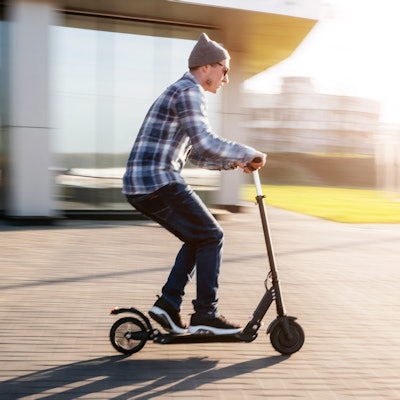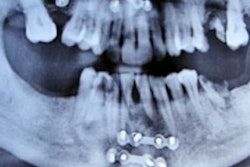
Riders of standing electric scooters (e-scooters) commonly experience head and face injuries due to multiple factors, including the troubles they have breaking their own falls, according to a study published in the November issue of the Journal of Oral and Maxillofacial Surgery.
About 60% of patients who visited the emergency department in a major urban area with scooter-related trauma had head and face injuries, the researchers found.
"Although providing an innovative and economical method of urban 'last mile' transport, e-scooters have also been shown to be significantly associated with craniofacial injuries," wrote the authors, led by Bhavin Trivedi, DDS, of the department of biomedical sciences at the Texas A&M College of Dentistry (J Oral Maxillofac Surg, November 2019, Vol. 77:11, pp. 2292-2297).
E-scooters quickly have become popular ways to get around urban areas across the U.S. The increase in popularity has led to a rise in traumatic craniofacial injuries associated with this convenient mode of transportation, according to the authors. E-scooter riders are exposed to falls and injuries due to several factors, including ergonomics. They can also have trouble breaking their falls because their hands are busy steering the e-scooters, making them more vulnerable to craniofacial injuries, they noted. Additionally, these injuries require specialist intervention ranging from dentoalveolar splinting to extensive facial reconstruction, highlighting the implications of craniofacial trauma risk associated with the use of these scooters.
This study aimed to determine the types of craniofacial trauma directly related to e-scooter use in the major urban center of Dallas. The researchers looked at a seven-month period, starting in July 2018 when the e-scooters became available in the area.
They examined the medical records of patients who went to the emergency department for e-scooter-related trauma. The team calculated results for all variables, including incident notes, patient interviews, diagnostic tests, treatment, and contributing factors, such as the use of alcohol and protective equipment.
The results showed that 52 of the 90 patients who went to emergency departments with e-scooter-related injuries experienced injuries to their head and face. They experienced many types of craniofacial trauma, including cuts, bruises, concussions, intracranial hemorrhage, and Le Fort II and III fractures. Of the craniofacial injuries, 58% were considered severe.
Approximately 20% of all scooter-related trauma admissions involved alcohol use, and no riders had reported wearing helmets, though e-scooter rental companies make users sign disclosures, requiring them to wear protective gear and refrain from drinking alcohol, according to the study authors.
Though the results were telling, the study had some limitations. The researchers only studied emergency visits associated with e-scooter use at a single trauma center in a metropolitan area with four level I trauma centers. Also, the trauma reported likely was an underrepresentation of all injuries related to e-scooters because the results were limited to those riders who sought medical attention.
Craniofacial trauma associated with e-scooter use could be significantly reduced if riders wore appropriate protective equipment and had access to well-regulated bicycle lanes, the authors noted.
"Special focus on the factors contributing to traumatic events involving e-scooters, such as helmet use, pedestrian interaction, alcohol use, and policies regarding scooter use will help establish the best practices for the mitigation and treatment of such injuries," they wrote.




















